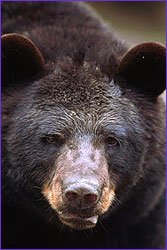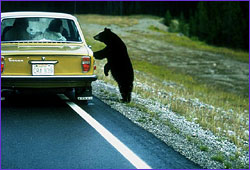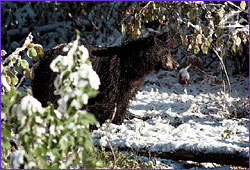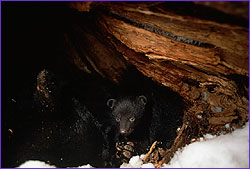 |
 |
|  The black bear, master dozer.
The black bear, master dozer.
|
Secrets of Hibernation
by Peter Tyson
Certain mammals have what many people might consider the good fortune to be able to sleep through the winter—to hibernate. They bed down in the fall and, for all intents and purposes, don't arise again until the spring. Raccoons and skunks do it. So do woodchucks and chipmunks, hamsters and hedgehogs, bats and bears. Some, particularly rodents, sleep very deeply, while others, such as bears, slumber more lightly.*
One of the most celebrated hibernators is the American black bear (Ursus americanus). It can go for as long as 100 days without eating, drinking, urinating, defecating, or exercising. Biologists have long acknowledged that hibernating black bears may have something to teach us, and they are now studying the animals with an eye to aiding everything from organ preservation to kidney disorders, from human hibernation to long-distance space travel.
With all this at stake, it's worth taking a closer look at the black bear and its stunning physiological feats. How can it survive for so long without drinking? Why doesn't hunger force it to wake up and seek a meal in midwinter? What triggers it to enter and leave its den?
The bear facts
One of nine species of bear in the world, the American black bear is found throughout North America, from the frozen tundras of the Yukon to the steaming bayous of Louisiana. Unlike, say, the panda, it is thriving as a species, with an estimated 600,000 individuals roaming the continent. Its sheer numbers have forced it into ever closer contact with people, with black bears regularly seen these days in and around urban housing developments and other man-made environments.
 Curiosity is often mistaken for aggression in black bears.
Curiosity is often mistaken for aggression in black bears.
|
|
Such contact can prove fatal for bears, whose hunger and curiosity have earned them a reputation for aggressiveness. Yet after millions of years of coping with predators—from now-extinct saber-toothed cats early on to rifle-toting hunters today—the black bear is a shy and retiring creature that will generally turn and amble away when approached. Indeed, according to data from the National Center for Health Statistics, for every person killed by a black bear in North America, 60 are killed by domestic dogs, 180 by bees, and 350 by lightning.
Its name is a misnomer, for the black bear displays greater color variations than most mammals. In Alaska, it even comes in a creamy white variety. Black bears eat berries and other fruits, nuts of all sorts, and flowers, leaves, roots, and other vegetation. True to their membership in the Order Carnivora, they will also devour the occasional small mammal or bird and will even scavenge animal carcasses.
Perhaps because black bears range widely—traveling when necessary well over 100 miles outside their normal home ranges in search of food—they have evolved an astonishing ability to find their way home. While a graduate student at the University of Minnesota, bear expert Lynn Rogers reported that one 450-pound male that found itself 119 miles from its den in mid-October walked straight back to its den over nine consecutive nights.
The heaviest weight recorded for wild black bears is 902 pounds (for a male) and 520 pounds (for a female). Those weights were measured at peak fall weight, however, and most black bears, especially after winter, weigh less than half that much. While they may look ponderous at their fattest in the late fall, they can sprint up to 30 miles an hour when they have to and can climb trees with great facility. Under ideal conditions, black bears can live more than 30 years, though they usually die far younger, mostly from encounters with people.
|  Sometime in late fall, black bears receive an unidentified signal that it's time to bed down for the winter.
Sometime in late fall, black bears receive an unidentified signal that it's time to bed down for the winter.
|
Nesting instinct
Preparations for over-wintering begin in the summer, when bears begin gorging carbohydrate-rich berries and other foods to put on weight. During this period, they can gain as much as 30 pounds per week. In early autumn, a bear (and its cubs, if any) will rake leaves, twigs, and other plant materials into the den to form a nest. Throughout the fall its activity level steadily drops until it ends completely when the bear enters its den.
Bears make dens in burrows, caves, hollowed-out trees, and rock crevices. Dens of the bears Rogers studies in Minnesota typically feature entrances just large enough for a bear to squeeze through; interior chambers measure two-and-a-half to five feet wide and two to three feet high.
It's cramped for a single bear, much less for a mother and her cubs. But that's the way bears like it: Black bears do no exercising of any sort during the winter months, prefering to lie rolled into a tight ball, with their heads between their forepaws and their heavily furred backs exposed to the worst of the cold. Dens themselves offer little insulation. In Minnesota, dens with open entrances are about as warm inside as outside, where the temperature, Rogers says, often plummets to as low as -28°F. Bears keep warm using their great bulk, their inches-deep layer of fat, and their fur, which more than doubles its insulative value during the fall.
Missing beats
Once a black bear begins hibernating, it can doze for many months with a body temperature of 88°F or higher, which is within 12°F of summer levels. By contrast, the body temperature of smaller hibernators such as marmots, chipmunks, and ground squirrels may drop below 40°F. These daintier creatures must awaken every few days, raise their body temperatures to summer levels, eat stored food, and pass wastes.
 Hibernating black bears, particularly mothers with cubs, sleep lightly, and bear expert Roger Powell of North Carolina State University says he has never approached a den in which a resident bear was not watching him come.
Hibernating black bears, particularly mothers with cubs, sleep lightly, and bear expert Roger Powell of North Carolina State University says he has never approached a den in which a resident bear was not watching him come.
|
|
Bears can go on slumbering because their warm pelts and lower surface-to-mass ratio allow them to better retain body heat. This, in turn, enables them to cut their metabolic rate in half. Using telemetry, Edgar Folk of the University of Iowa monitored the heart rate of a captive bear in Alaska as it slept. In the early fall, its heart beat 40 to 50 times a minute for most of each night. By December, when the bear was deep in hibernation, its sleeping heart rate had slowed to as few as eight beats a minute.
Black bears keep their heads and torsos warm enough that they can wake if disturbed, though some may take awhile to do so. In a 1981 article in Natural History, Rogers told of the time he accidentally fell onto a six-year-old female in her den. Even though her cub bawled, she didn't wake up for at least eight minutes. On the other hand, some individuals can revive disconcertingly quickly. Rogers again:
On January 8, 1972, I tried to hear the heartbeat of a soundly sleeping five-year-old female by pressing my ear against her chest. I could hear nothing. Either the heart was beating so weakly that I could not hear it, or it was beating so slowly I didn't recognize it. After about two minutes, though, I suddenly heard a strong, rapid heartbeat. The bear was waking up. Within a few seconds she lifted her head as I tried to squeeze backward through the den entrance. Outside, I could still hear the heartbeat, which I timed (after checking to make sure it wasn't my own) at approximately 175 beats per minute.
*This has led some biologists to differentiate between the hibernation of, say, jumping mice and the "winter lethargy" of bears. Ours is not to quibble, however, and for the purposes of this article, sleeping through the winter—to whatever degree—will be referred to as hibernation.
Continue: Bear essentials
Animal Transformations |
Miracle of Rice
Secrets of Hibernation |
Build a Rice Paddy |
Resources
Transcript |
Site Map |
Japan's Secret Garden Home
Editor's Picks |
Previous Sites |
Join Us/E-mail |
TV/Web Schedule
About NOVA |
Teachers |
Site Map |
Shop |
Jobs |
Search |
To print
PBS Online |
NOVA Online |
WGBH
© | Updated December 2000
|
|
|